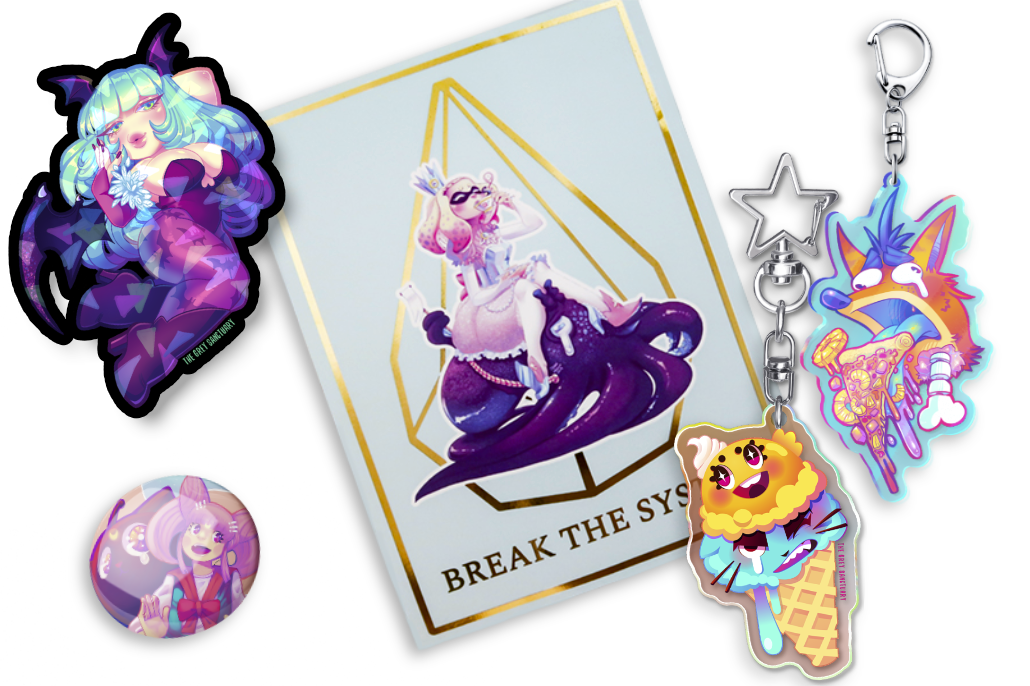

Little Cathedral Blog
When Should I Apply A Commercial Use?
We all know that navigating the freelance world in the creative field can be daunting and complicated when it comes to gray areas such as copyrights, and fair use, among other things. However, there seems to be misinformation when it comes to pricing our work and establishing boundaries when clients use our work under any circumstances.
What’s The Definition Of Commercial Use?
Commercial use refers to the copyrighted material (creative works, such as text, images, music, or videos from the creator or copyright holder that has exclusive rights to distribute, produce, display, and perform the work) that is directly or indirectly used for generating revenue or business purposes regardless of the method, medium, or platform. A legally binding contract similar to an Art Licensing Agreement. Most of the time, a “commercial use” is based on an exclusive license granted to the client with a specific rate, such as a flat fee or a percentage.
Limited commercial use refers to restricting a number of uses of a product, license, or intellectual content. This may also include expiration dates.
Personal use is limited to enjoyment or educational purposes, which focuses on non-commercial activities and poses fewer risks for copyright infringement or penalties.
How Can I Apply It?
First let’s clarify that each artist, creative, or independent contractor price their work depending on their demands, expertise, and needs besides researching and following the market value as a guide.
When discussing the project’s details, ask your client about their objectives with the copyrighted work and explain the protocols for commercial use. You can list all the prices of the required assets or deliverables of the project and add “commercial use” as a fee or license with the respective cost. This should be clear, visible, and detailed (if necessary) on any official document such as an invoice or estimate to avoid misunderstanding, surprise elements, or miscommunication.
- Explain what it doesn’t cover, including penalties and restrictions.
- Create an invoice and a contract (with TOS) with important information about the client’s objective and the deliverables or commercial fees.
- Make a breakdown of the prices of each deliverable or commercial fee that that client will use.
- Establish a limited period (time frame), medium (billboard, website banner, etc.), product (mugs, textiles, posters, etc.), and location (targeted geographical zones).
- You can price accordingly based on your client’s research: corporations with the biggest platforms, revenues, and audience should be charged three times the rate compared to individual businesses.
In What Should It Be Applied?
In any copyrighted material or personal work you own, including commissions that your client requested. A little reminder that in commissions, the artist is considered the author and copyright holder of the derivative work done for the client, regardless if the concept or the idea belongs to the client or how much was paid.
This shouldn’t be confused with “Work for Hire”, since the artist resigns any rights and transfers them to the client. Commission doesn’t equal Work for Hire, and such terms shouldn’t be interchangeable. Both concepts are entirely different and have their unique purposes and protocols. Mixing these terms altogether in a situation may have consequences since, by default, WFH possesses heavy risks.
Scenarios Considered For Commercial Use
Each client has a unique problem and solution, analyze each situation and decide the best route for you. If any of these situations answers the question with a yes, then rest assured it has the potential to be considered for commercial use.
- Incorporation – Is your copyrighted material or work affiliated with or representing an individual, business, organization, or entity with the goal of a commercial advantage with promotional efforts, exhibition, or internal business protocols?
- Commercial Platforms Placements – Is your copyrighted material or work published or distributed in commercial advert spaces such as billboards, mobile billboards, theaters, websites, magazines, books, or streaming/cable services?
- Marketing & Promotion -Is your copyrighted material or work used for campaigns, advertising materials or to increase either sales or expand the business exposure?
- Market Value Influence – Does your copyrighted material or work have the potential to be affected in the market value due to economic harm, improper use, or infringement?
- Endorsement and Sponsorship: Is your copyrighted material or work promoted on a service, brand, or product to gain compensation and/or other benefits?
- Financial Involvement or Intention – Does your copyrighted material or work have the sole purpose of generating income by physical/digital sales, licensing, or advertising to promote a product or service by your client?
You Can Charge A Commercial Use When Your Work Is Used On:
- Software, mobile apps, or e-commerce stores.
- Banner display, advertisement, promotions, and marketing.
- Award presentations, workshops, exhibitions, or documentation series.
- Resale and production of goods. (your merch or personalized gifts).
- Digital sales like download files, courses, or community subscriptions.
- Physical sales like copies, limited edition items, or one-of-a-kind pieces.
- As an incorporation to a product, even if the work is a small portion (your design in a brand’s item).
- Virtual events such as donations, engagement (PNG/GIF emotes), or promotional events in streaming or pre-recorded services (audio and/or visual).
- Commissions for different assets such as 2D/3D character design (including VTubers), prop designs (ex. clothing), and background designs. (ex. wallpapers, animated overlays, etc.)
When It Is Considered For Personal Use
It is less likely to face penalties or complications if the copyrighted material or work is considered “personal use” by the following:
- It must fall under “fair use” which is acceptable with the limited section of the work including quotes, for purposes such as commentary, criticism, news reporting, and academic reports.
- Its involvement is around non-commercial or non-monetary activities (transactions).
- The usage is limited to personal moments (enjoyment) or educational spaces.
- Generally, it can be used or consumed, without the consent or permission from the copyright owners, depending on the usage or other restrictions.
Conclusion
Please consider obtaining compensation for your work, especially when the client requests commissions for their OC (original characters). Many artists believe that in commissions, the deliverable or final work belongs to the client and shouldn’t interfere with whatever usage the client does at the end. Including taking advantage of the situation and making a profit with your derivate work without your consent, thus making you lose future potential income.
Thank You For Reading!
If you like my work and documentation and wish to see more, please consider contributing to my growth and hard work with more exploration, investment, and website maintenance.












Leave a Reply